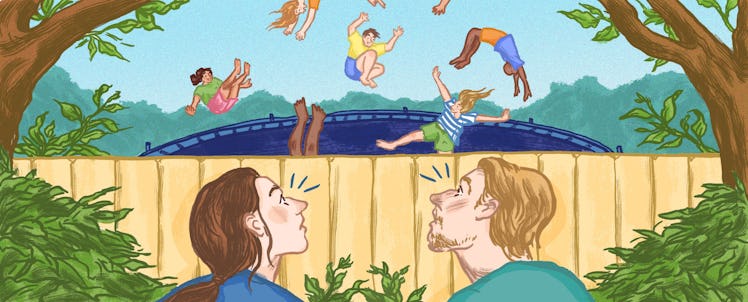Trampoline Sales Are Booming. Injuries Are Sure to Follow.
American backyards are going bounce-crazy this summer. God help us all.

Buying a trampoline for the kids is the equivalent of dad going in on that ’98 Porsche 911 Carrera. It might not be the most practical vehicle — and it probably isn’t a particularly cost-effective, safe, or wise purchase — but damn if it isn’t fun as hell. Wait until your neighbors get a load of it. Right now, the trampoline splurge is happening at pace in America. Trampoline sales have never been higher — more than Christmas and Fourth of July — according to one leading trampoline brand, and everywhere trampolines are sold out, with backlogs that run well past July. This is indicative of the turn of attention to our backyards, as well as, in all likelihood, peer pressure. There will be laughing and jumping in many a backyard this summer. There will also be injuries and buyer’s remorse. It’s the American way.
In the best of times, trampolines run out of flavor quickly. You see, after a day or so, kids get bored with simply bouncing, alone, under supervision, as the manufacturers and health professionals will tell you these products are meant to be used. So they up the risks to up the rewards.
As you might imagine, experts are very much a buzzkill when it comes to this move. “To be fair, everything is dangerous — playgrounds are dangerous, jungle gyms are dangerous,” says Dr. Gaia Georgopoulos, a pediatric surgeon who has formally studied trampoline injuries (results: there will be fractures, lots of fractures). “But trampolines are relatively dangerous because families or parents don’t know what rules of participation should be.” Without missing a beat, she lists the rules of trampolines:
- “No more than one person on the trampoline at a time.
- The trampoline should be placed on a soft area. Grass or sand, not on concrete or near metal faces.
- When someone is jumping on a trampoline they need a spotter.
- Most pediatricians and pediatric orthopedics feel that anyone under the age of five shouldn’t be on a trampoline. Their bones are not strong enough.”
Now, Dr. Georgopolous’ rules look downright libertarian next to the AAP’s more draconian guidelines:
- “Somersaults and flips should be discouraged. Failed attempts at these maneuvers can cause devastating cervical spine injuries, resulting in permanent disability or even death.
- Springs should be covered with padding to avoid pinching fingers or toes and to protect against falling into the crevice between the springs.
- Trampolines should be inspected regularly for tears, rust and detached springs or pads.
- Keep ladders away from trampolines as they provide a mechanism for small children to get on the trampoline and jump without supervision.
- Homeowners with a trampoline should verify that their homeowner’s insurance covers trampoline-related claims.”
It doesn’t take a pandemic to realize how dangerous trampolines are. Over a nine-year period, one study counted more than one million emergency department visits that cost over $1 billion to treat. Smaller children are, by one estimate, 14 times more likely to be injured. The problem here isn’t that trampoline themselves are dangerous. It’s just that to have fun on a trampoline requires danger. Kids recognize that if you don’t up the danger factor with, maybe aerial wrestling you’re just jumping up and down. This is why 75 percent of injuries occur on the trampoline, with multiple kids. This is why you need to sign your life away in trampoline parks. It’s why George Nissen, the inventor of trampolines could not afford to insure his company after several children suffered paralysis or were maimed after falling on his equipment and shuttered his factory in 1989.
When it comes to safety, there’s no great time to have a trampoline. But a pandemic offers what one could safely say is the worst time to do so. While pediatric emergency departments are not overflowing — thanks to the fact that COVID-19 has been most virulent towards the elderly, not kids — it is still not a good time to go to the hospital. Hospitals remain strained across the nation. Adding to that with trampoline injuries could lead to further strain. The line to “more lives lost” isn’t a dotted one.
So is the trampoline worth it? No. Instead, buy a sprinkler, a ball, and a bucket. Let the kids figure out how to put the three together. Let their imaginations, not their bodies, fly. That’s what summer is all about.
This article was originally published on